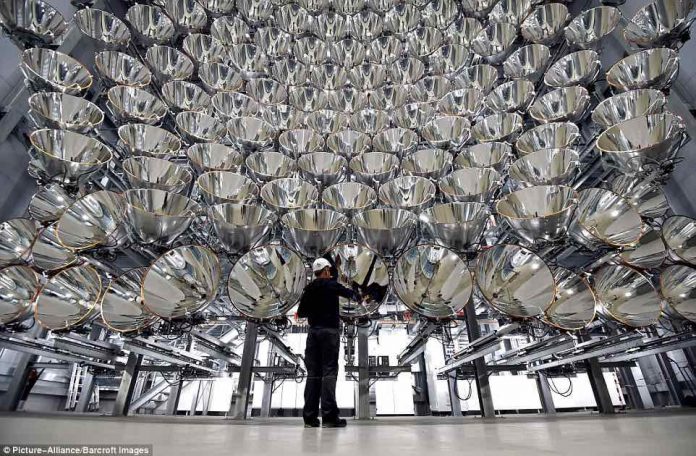German scientists have constructed what is the world’s largest artificial sun. This entity is something which might prove useful in the end.
The honeycomb-like setup involves 149 individually adjustable xenon short-arc lamps that can produce about 10,000 times the intensity of the natural solar radiation on Earth’s surface. To illustrate how powerful the lamps are, a single one can light a projector for a large cinema.
“We use the lamps because their light is the most similar to the sun,” project manager Kai Wieghardt explained to Spiegel.
If all the lamps are targeted to a single spot, Synlight can produce temperatures of up to 3,500 degrees Celsius or 5,432 degrees Fahrenheit.
The goal of the experiment, as the Guardian reported, “is to come up with the optimal setup for concentrating natural sunlight to power a reaction to produce hydrogen fuel.”
You’ve probably heard of concentrated solar before. Concentrated solar facilities, like the ones being built in Nevada, Dubai and Morocco, involve a large field of movable mirrors that can harness sunlight and power a steam turbine to generate electricity.
Likewise, Synlight researchers are “investigating the possibility that a similar setup could be used to power a reaction to extract hydrogen from water vapor, which could then be used as a fuel source for airplanes and cars,” according to the Guardian.
Hydrogen fuel—which has zero pollutant emissions and no greenhouse gases—has been touted as the fuel of the future. Hydrogen is produced by electrolysis, the process of splitting water into hydrogen and oxygen, and requires large amounts of electricity. Hydrogen fuel projects are seen as cost-prohibitive on a commercial scale.
But as the Associated Press explained, researchers hope to bypass the need for electricity by harnessing the vast and renewable energy of the sun instead.
Or, as DLR put it, Synlight researchers will be focusing on so-called “solar fuels.”
The Jülich experiment currently uses artificial light and requires a lot of electricity to operate. Running the array for only four hours sucks up as much electricity that a four-person household would use in a whole year. The project was also very expensive, costing $3.8 million to build.
But the researchers hope to eventually use actual sunlight to produce hydrogen. Bernhard Hoffschmidt, director of DLR’s Institute for Solar Research, explained to AP that once researchers have mastered hydrogen-making techniques with Synlight, the process can be scaled up ten-fold on the way to reaching a level fit for industry.
Although Hoffschmidt noted that hydrogen can be incredibly volatile, by combining it with carbon monoxide produced from renewable sources, scientists could potentially make eco-friendly kerosene for the aviation industry.















